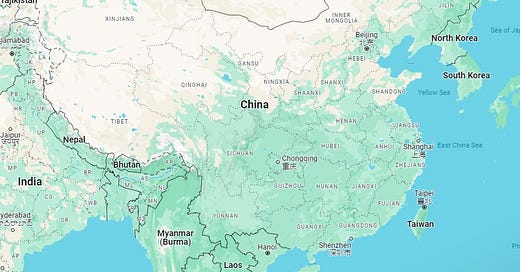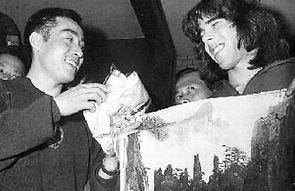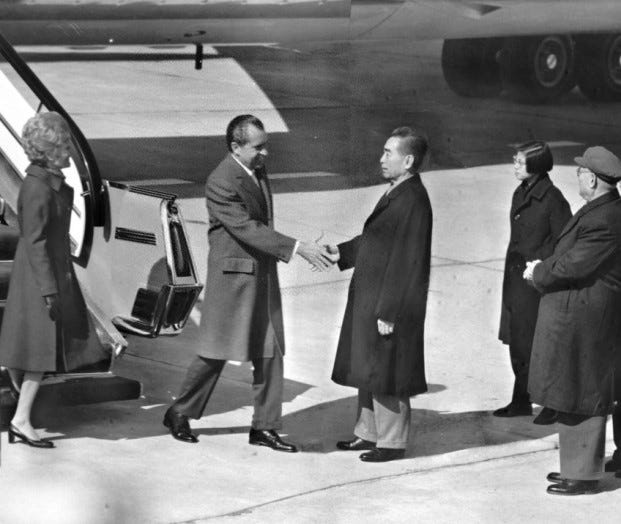Many people I have spoken to from Western countries seem to have a blind spot about the ideological differences within Communism which led to a massive fracturing of the Communist world. Some think that the Soviet Union and the People’s Republic of China were a united monolith. Nothing could be further from the truth.
The purpose of this blog is to focus on Vietnam, which a large part of this article is dedicated to. Occasionally, that requires us to take a step back and look at regional geopolitics to understand how the moves of other powerful countries in the region ultimately affect Vietnam.
In a little over a decade, the Communist world around Asia was experiencing varying degrees of war as border skirmishes were popping up around China and South East Asia. At one point, there was the threat of a nuclear exchange unless China and the Soviet Union could peacefully resolve their issues, which thankfully ended without incident.
As conflict died down in one region, it manifested in a different region as a proxy war. It could be said that American troop withdrawal from South East Asia added to the devastation of this proxy war because America left a power vacuum in their wake. This resulted in a massive mess to clean up. A weary ceasefire held until ideological conflict became a moot point with the complete dismantling of the Soviet Union.
This is the timeline of the events of the Communist Civil War. It starts with the early ideological split and document the major events and hostilities which mark the crucial events along the way. Events such as the Korean War or the struggle of intelligence agencies to exert influence via proxy wars and covert actions against third world nations are not mentioned. The goal here is not to talk about the Cold War (which was the struggle between Communism and the West), but to document the crucial dates in the ideological struggle within Communism.
Prelude:
March 5, 1953. Stalin dies.
September 7, 1953. After several months of struggle, Nikita Khrushchev was able to consolidate power and take over Stalin’s position as the General Secretary of the Communist Party of the Soviet Union.
February 25, 1956. Khrushchev delivered the "Secret Speech" at the 20th Party Congress. This speech denounced Stalin's purges and pushed for peaceful coexistence with other nations. Khrushchev cut military funding and focused on increasing economic output, specifically agriculture, as well as allowing increased freedom in the arts.
1956-1962. Doctrinal tensions devolve between China and the Soviet Union as the Soviets sought to de-Stalinize Communism. Mao believed this was a divergence of Leninist theory. China declared the Soviet Union to be Social Imperialists, which Lenin would describe as Socialist in words and Imperialist in deeds.
October 23 to November 4, 1956. The Soviet Union put down a revolution in Hungary causing criticism from Mao saying this move was delegitimizing Communism.
1959 to 1961. The Chinese Great Leap Forward ends up causing The Great Famine, in which, an estimated 15 to 55 million people died of starvation, although most estimates fall in the middle range of those numbers. This prompted serious criticism of Chinese economic management from the Soviets which further fed tensions.
Starting in the early 1960’s, China was becoming increasingly agitated over what they called the unfair treatment imposed on China during the Qing dynasty. In the treaties of Aigun and Peking, China was forced to give up more than half of Manchuria to the Russians. Although it is considered resolved today through a couple of formal agreements, it is still a source of tension.
Late 1961. Tensions arise after border disputes in Manchuria causing the Soviets to break off diplomatic relations with China.
Late 1962. China breaks off diplomatic relations with the Soviet Union due to Khrushchev not going to war with the U.S. over the Cuban Missile Crisis. Mao considered it a total loss of face and said "Khrushchev has moved from adventurism to capitulationism" while Khrushchev believed Mao’s belligerent attitude would provoke a war with the West.
October 1967. Presidential candidate, Richard Nixon began suggesting easing tensions between the U.S. and China when he wrote in Foreign Affairs magazine, "we simply cannot afford to leave China forever outside the family of nations, there to nurture its fantasies, cherish its hates, and threaten its neighbors. There is no place on this small planet for a billion of its potentially most able people to live in angry isolation." If Nixon could bring China into the U.S. sphere of influence, there was a chance to resolve the global political rivalry diplomatically.
1968. The Brezhnev Doctrine was enacted by the Soviets to proclaim that any threat to socialist rule in one country was a threat to the entire system, therefore justifying intervention by other Communist states. Prior to this point, there was an agreement that no Communist country would invade another Communist country. China feared this doctrine could be used as justification for a Soviet invasion of China.
August 20-21, 1968. The Soviet Union, in a coalition with other Warsaw Pact countries invades Czechoslovakia under the Brezhnev Doctrine.
January 20, 1969. Richard Nixon takes office as the President of the United States.
Sino-Soviet War breaks out
March 1969. After the Soviets invade Czechoslovakia, China decided they needed to stand up to the Soviet Union and take back a few of the contested Manchurian islands because existing treaties were unclear about who owned these river islands.
May 5, 1969. Soviet Premier Kosygin traveled to India to meet with Prime Minister Indira Gandhi about the possibility of a Soviet-Indian alliance against China. India has always been a natural enemy to China as they share multiple disputed borders and tend to be economic rivals over the previous few thousand years. In August 1971 the Indo-Soviet Treaty of Friendship and Cooperation was signed.
May 14-19, 1969. Nikolai Podgorny visited North Korea to convince Kim Il Sung to ally with the Soviet faction. Kim declined to join the Soviets. In a show of support for China, North Korea decided not to attend the World Conference of Communist Parties that was held in Moscow the following month.
June 17, 1969. U.S. Senate Majority Leader Mike Mansfield sends a letter, with the support of the White House, to request a meeting with Mao to discuss thawing relations between the two countries. The Chinese reply was harsh with Premier Zhou giving a speech condemning the aggression in Vietnam and accusing the U.S. of occupying Taiwan, which Zhou insisted, belonged to China. Over the next few months, Nixon traveled to Asia to meet with various heads of state to try to persuade China to attend a diplomatic meeting in hopes of opening diplomatic relations with the U.S.
August 1969. Conflict spreads as the war in Manchuria reached out from the eastern Sino-Soviet border to the western border as conflict broke out in Xinjiang Autonomous Region. Tensions escalated as threats of a nuclear exchange were made by China.
September 9, 1969. Soviet and Chinese diplomats attend Hồ Chí Minh’s funeral in Hà Nội. Tensions were so bad, the diplomats refused to even be in the same room with each other. North Vietnam was forced to play peacemaker by forwarding messages between the two countries in an effort to keep the peace while representatives were in Hà Nội. When Premier Alexei Kosygin was returning home, his flight was not allowed to enter Chinese airspace and he was forced to go around China. During a stop in India, Kosygin received a message that the Chinese were interested in a ceasefire. He immediately rerouted the plane to Beijing. Tensions were eased when Soviet Premier Kosygin and Chinese Premier Zhou Enlai met to negotiate a ceasefire. The matter was not able to be fully resolved and tensions still remained due to doctrinal differences continuing to split the Communist world.
Ping Pong for Peace
April 6, 1971. The American table tennis team was in Nagoya, Japan for the 31st World Table Tennis Championships when they received an invitation to visit China following a match between Glenn Cowan of the US and Zhuang Zedong of China.
April 10, 1971. Despite popular belief to the contrary, it was not Forest Gump, but it was the entire American table tennis team, headed by Glenn Cowan, with accompanying journalists who travelled to Beijing. They were the first official American delegation to travel to the Chinese capital since 1949. During that trip, an unofficial communication was extended from the People’s Republic of China toward the U.S. State Department, which indicated China would be interested in resuming diplomatic talks with America.
July 9-11, 1971. China discretely arranged for a meeting between Chinese Premier Zhou Enlai and National Security Advisor Henry Kissinger in Beijing. These talks led to the historic “week that changed the world” trip of President Richard Nixon to Beijing.
July 15, 1971. President Nixon announced on live television that he would visit China the following year.
February 21-28, 1972. President Nixon arrived in China. As Nixon mentioned in his memoir, following a bit of a blunder after John Foster Dulles had failed to shake the Chinese Premier’s hand, Nixon was careful to quickly shake hands with Chinese premier Zhou Enlai at Beijing International Airport as soon as he exited Air Force One. Everything was riding on this important meeting, and he didn’t want anything to mess it up. He was determined to drive home the message that common interests trump divisions.
Americans leave Vietnam
January 27, 1973. Led by the Americans, North and South Vietnamese representatives engaged in peace talks in Paris, France where it was agreed that the U.S. would withdraw troops from Vietnam within 60 days. This agreement was never actually ratified by the U.S. Senate due to small hostilities which resumed nearly the same day.
March 1973. Fighting resumes as North Vietnam found themselves in a better fighting position after a break gave the opportunity to secure their military infrastructure.
August 8, 1974. President Nixon resigns the Presidency of the U.S.
Early 1975. In preparation for the American exodus of the region, the Cambodian Pol-Pot régime started purging its ranks of Vietnamese personnel.
April 17, 1975. Phnom Penh falls to the Khmer Rouge, ending the Cambodian Civil War. Any Khmer Republic forces were immediately executed. Western Expats who took refuge in the French embassy were taken to the Thailand border and released into Thailand.
1975-1979. 1.5 to 2 million people, nearly 25% of Cambodia's population were killed by the Pol Pot regime.
April 30, 1975. The U.S. had already been withdrawing support of The (Southern) Republic of Vietnam since the 1973 Paris Accords. A final North Vietnamese offensive removed any remaining resistance by the Southern Republic and Saigon fell.
July 2, 1976. The (Northern) Democratic Republic of Vietnam officially absorbs The (Southern) Republic of Vietnam into the current state of The Socialist Republic of Vietnam.
Vietnam goes to war with Cambodia
December 23, 1978. After frequent intrusions by the Khmer Rouge into the Vietnamese southern border over several years, hostilities broke out between Vietnam and the Khmer Rouge. Frequent Khmer Rouge raids destabilized South Vietnam as entire villages were reported massacred by the Khmer Rouge, looking to cleanse the Mekong Delta region of Vietnamese. Vietnam was finally able to reorganize after the absorption of The (Southern) Republic of Vietnam and started to secure the southern border. It is important to understand that Vietnam maintained a pro-Soviet ideology while the Khmer Rouge was backed by the Chinese and maintained a Maoist ideology.
December 25, 1978. Vietnam launched a full-scale invasion of Cambodia, occupying the country for two weeks before they were able to remove the Pol-Pot regime and put an end to the genocide.
January 8, 1979. The pro-Vietnamese People's Republic of Kampuchea was established in Phnom Penh. For nearly ten years until 1990, the PRK remained in power until the Australian-sponsored Cambodian Peace Plan was organized at the Third Jakarta Informal Meeting. It was agreed power would be shared with the Coalition Government of Democratic Kampuchea (CGDK). Prime Minister Hun Sen (the same person sponsoring the Mekong River canal project I wrote about a little while ago) would remain in power from 1985-2023.
China invades Vietnam
February 17, 1979. The Chinese were irritated that the Vietnamese destroyed their Chinese backed Cambodian regime, so they launched an invasion of Vietnam. Unfortunately for the Chinese, the Vietnamese were severely battle hardened by that point and the Chinese were only able to get a few kilometers into Vietnam before their invasion was halted.
March 16, 1979. For nearly four weeks, the Chinese forces occupied a small sliver of Northern Vietnam until the Chinese finally decided they taught the Vietnamese a valuable lesson and retreated back across the Chinese border. China declared that their mission was successful by showing their dissatisfaction with the Vietnamese and saw no further need to maintain hostilities. Chinese and Vietnamese governments remained estranged until the collapse of the Soviet Union when diplomatic relations resumed.
The Soviet Union collapses, effectively ending the Communist Civil War
By the late 1980’s it became clear that Communism was failing universally on an economic level and Communist countries which hoped to survive needed to create economic reforms to allow free market economics in. The Soviet Union, under increased economic pressure, leading to political unrest dissolved and the American led economic order arose as the dominant global economic system.
December 26, 1991. The Soviet Union dissolved after a series of independent states started breaking off. The leaders of three of its founding members, Russia, Belarus, and Ukraine, declared that the Soviet Union no longer existed. Gorbachev resigned and what was left of the Soviet parliament voted to dissolve the union.
History doesn’t end with a final date on a calendar. The doctrinal Civil War may have ended, but the political maneuvering remains. The exact same countries which are fretted about in the global news media today are the same countries which were playing the global chess game over fifty years ago. As I compare this to political maneuvering today, it seems nothing about the nature of the political game has changed.
If you want to read about the details of the Nixon trip to China and learn about some behind the scenes events which made it happen, this is a wonderful resource.
USC - U.S. China Institute, Getting to Beijing: Henry Kissinger's Secret 1971 Trip








Excellent read! A forgotten history…especially in the West.
The Communist regimes in all of these countries tried to rewrite and paper over the shared history of these various nations and pretend that they no longer mattered to them as members of the international communist movement. One of my contributions to anti-war protests on my campus was to talk about this real history and how it undercut the narrative pushed in Washington DC to justify the American involvement. People still ignore this history today when talking especially about Russia and China, between which there is no love lost but only the hunt for advantage. The balance between them has drastically shifted and China still remembers.